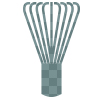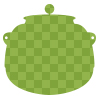茶道具のいろは 『茶碗』
茶碗
お茶を点ててくださる「亭主」の想いを容れる器、客がいただく器が茶碗です。
そう考えると数ある茶道具の中で最も重要視される道具です。(茶席に入った誰もが
必ず手にするお道具です)
茶碗は大きく三つに分類されます。
1.唐物
中国からの渡来品。
12世紀末期の宋代に喫茶の文化が渡ってきたタイミングに多くが渡来しました。
代表的なものに「天目」や「青磁」があり、江戸時代に入ってからは「染付」や
「赤絵」が登場します。
2.高麗物
朝鮮からの渡来品。
高麗茶碗は李氏朝鮮時代(李朝)の製品で、室町時代末期から茶席に登場します。
「井戸」や「伊羅保」が有名です。
3.和物(日本製)
千利休の時代に、唐物や高麗物の模倣ではない日本オリジナルの「瀬戸」や「楽」などが
創出されます。現在では『一楽二萩三唐津』と言われるように「楽焼」「萩焼」「唐津焼」が
珍重されています。
【参考文献】点前道具〈下〉扱いと心得 (茶道具百科)/淡交社編集局編
アバ茶流「茶碗」の解釈
いきなり何万もする茶碗を買うのは気が引けることでしょう。
それなら身近にある器で使えそうなものがないか探ってみるのは如何でしょうか?
毎日使っている「飯碗」。コーヒーがお好きな方は「カフェオレ・ボール」なんかも使い勝手
があってオススメです。これでなければいけない!という固定概念に捕らわれず自分好みに
お茶碗を見つけて見ましょう!
お茶の世界は、茶道具ではないものを茶道具として使うことを「見立て」と言います。
あの利休さまも様々な見立てをされて、今ではそれがすっかり茶道具として定着しているもの
まであります!
・魚籠(びく)=茶籠(お花を入れる道具)
英訳 English Version
Chawan (Tea bowls)
In a tea ceremony the host pours particular sincerity, heartfelt hospitality and creativity into the selection and use of the chawan (tea bowl). It is then from this chawan the guest partakes of tea, and the host’s heartfelt sentiment. Thought of in this way, out of all the equipage used in the tea ceremony, the chawan takes centre stage. (All people that participate in a tea ceremony hold and view the chawan at one time.)
Chawans can be divided into three categories:
1. Karamono
Karamono are chawans imported from China. A large influx of karamono chawans came to Japan towards the end of the 12th century together with Song Dynasty (960~1279) tea drinking culture. Classic examples of this period are Tenmoku and Celadon Porcelain, and Sometsuki (blue and white porcelain) and Aka-e (red-painted ceramic) appeared during the Edo Period.
2. Kōraimono
Kōraimono generally refers pottery imported from Korea. Kōrai chawans are vessels made during the Joseon Dynasty (1392~1910), and a large influx came to Japan towards the end of the Muromachi Period(1336~1573). Ido and Irabo styles are among the most famous.
3. Wamono (Japanese)
Wamono are not Japanese imitations of Karamono and Kōraimono, rather they are original Japanese pottery styles that emerged during Rikyu’s lifetime. Famous names included Seto and Raku wares. Just as the saying goes ‘Raku number 1, Hagi 2 and Karatsu 3’ (ichi raku ni hagi san karatsu), Raku, Hagi and Karatsu wares are particularly prized among Wamono.
Reference for the above: Tea Ceremony Equipage (2nd half): Handling and the Thought Behind Each (Tea Equipage Encyclopedia) Tankosha Publishing Co., Ltd.
Avant-Garde Cha Kai’s thoughts on chawans
Chawans can be very expensive. Most people are hesitant at jumping in to a big purchase, so before you do, how about looking through the ceramics you already own for items you can use as a chawan? For example, you could use your everyday rice bowl or coffee lovers might have a café au lait bowl. Don’t get stuck in stereotypes, find a chawan you like!
In the world of Tea, we call items not originally made for Tea but adapted for use in the tea ceremony ‘mitate’ (mi-tah-teh). Rikyu used many items as mitate in the tea ceremony, and many of these items are now standard items in the tea ceremony! For example, Rikyu used ‘biku’ fish baskets as flower vases. Now they are know better as flower baskets for the tea ceremony.
By SadoSamurai







